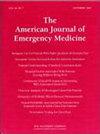A clinical prediction model for safe early discharge of patients with an infection at the emergency department
IF 2.7
3区 医学
Q1 EMERGENCY MEDICINE
引用次数: 0
Abstract
Background
Every hospital admission is associated with healthcare costs and a risk of adverse events. The need to identify patients who do not require hospitalization has emerged with the profound increase in hospitalization rates due to infectious diseases during the last decades, especially during the COVID-19 pandemic. This study aimed to identify predictors of safe early discharge (SED) in patients presenting to the emergency department (ED) with a suspected infection meeting the Systemic Inflammatory Response Syndrome (SIRS) criteria.
Methods
We conducted a prospective cohort study on adult non-trauma patients with a suspected infection and at least two SIRS criteria. We defined SED as hospital discharge within 24 h (e.g. direct ED discharge or rapid ward discharge) without disease-related readmission to our hospital or death during the first seven days. A prediction model for SED was developed using multivariate logistic regression analysis and tested with k-fold cross-validation.
Results
We included 1381 patients, of whom 1027 (74.4 %) were hospitalized for longer than 24 h or re-admitted within seven days and 354 (25.6 %) met SED criteria. Parameters associated with SED were relatively young age, absence of comorbidities, living independently, yellow or green triage urgency, lack of ambulance transport or general practitioner referral, normal clinical impression scores, and risk scores (i.e., qSOFA, PIRO, MEDS, NEWS, and SIRS), normal vital sign measurements and absence of kidney and respiratory failure. The model performance metrics showed an area under the curve of 0.824. The validation showed a minimal drop in performance and indicated a good fit.
Conclusion
We developed and validated a model to identify patients with an infection at the ED who can be safely discharged early.
急诊科感染患者安全提前出院的临床预测模型。
背景:每次住院都会产生医疗费用和不良事件风险。过去几十年间,尤其是在 COVID-19 大流行期间,传染病导致的住院率大幅上升,因此需要识别无需住院治疗的患者。本研究旨在确定急诊科(ED)就诊的疑似感染患者中符合全身炎症反应综合征(SIRS)标准的安全提前出院(SED)预测因素:我们对疑似感染且至少符合两项 SIRS 标准的成年非外伤患者进行了一项前瞻性队列研究。我们将 SED 定义为 24 小时内出院(如直接急诊室出院或快速病房出院),且在头七天内没有因疾病再次入院或死亡。我们利用多变量逻辑回归分析建立了 SED 预测模型,并通过 k 倍交叉验证进行了测试:我们共纳入了 1381 名患者,其中 1027 人(74.4%)住院时间超过 24 小时或在七天内再次入院,354 人(25.6%)符合 SED 标准。与 SED 相关的参数包括:年龄相对较小、无合并症、独立生活、黄色或绿色分诊紧急程度、无救护车转运或全科医生转诊、临床印象评分和风险评分(即 qSOFA、PIRO、MEDS、NEWS 和 SIRS)正常、生命体征测量正常以及无肾衰竭和呼吸衰竭。模型性能指标的曲线下面积为 0.824。验证结果表明,模型的性能下降很小,拟合效果良好:我们开发并验证了一个模型,用于识别可安全提前出院的急诊室感染患者。
本文章由计算机程序翻译,如有差异,请以英文原文为准。
求助全文
约1分钟内获得全文
求助全文
来源期刊
CiteScore
6.00
自引率
5.60%
发文量
730
审稿时长
42 days
期刊介绍:
A distinctive blend of practicality and scholarliness makes the American Journal of Emergency Medicine a key source for information on emergency medical care. Covering all activities concerned with emergency medicine, it is the journal to turn to for information to help increase the ability to understand, recognize and treat emergency conditions. Issues contain clinical articles, case reports, review articles, editorials, international notes, book reviews and more.

 求助内容:
求助内容: 应助结果提醒方式:
应助结果提醒方式:


